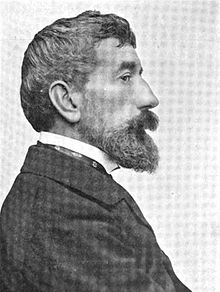Louis-Maurice Boutet de Monvel
| Louis-Maurice Boutet de Monvel | |
|---|---|
 |
|
| Born | Louis-Maurice Boutet de Monvel 18 October 1850 Orléans, France |
| Died | 16 March 1913 (aged 62) Paris |
| Occupation | painter and illustrator |
| Nationality | French |
| Education | Julian Academy |
| Genre | watercolors, illustrations for children's books |
| Notable works |
|
| Notable awards |
|
| Spouse | Jeanne Lebaigue |
| Children | Roger |
Louis-Maurice Boutet de Monvel (18 October 1850 – 16 March 1913) was a French painter and illustrator best known for his watercolors for children's books. He was a major figure in nineteenth-century children's literature illustration.
He was an academic painter who studied at the École nationale supérieure des Beaux-Arts in Paris under Alexandre Cabanel, Gustave Boulanger, Jules Joseph Lefebvre, and Carolus Duran. During the late 1870s he exhibited at the Salon de Paris and earned the medal of the third class in 1878 for his painting The Good Samaritan.
Boutet de Monvel was born in Orléans. Grandson on his mother's side to the tenor Adolphe Nourrit (1802–1839) and great-grandson on his father's side to the great Monvel – he was the great-great-nephew of Miss Mars – Maurice Boutet de Monvel was, in his own words, from "a family of gilt-edged artists". Furthermore, his father Benjamin Boutet de Monvel (1820–1880) was a renowned physics and chemistry professor and the author of several teaching manuals.
The second child in a family of nine children, Maurice Boutet de Monvel spent the majority of his childhood in Paris, where his father taught at Charlemagne secondary school. Permitted after his A' levels to take up studies in painting, he spent a year in close proximity to Louis-Henri de Rudder (1807–1881), before joining the École des Beaux-Arts in early 1870, where he was in the same class as Alexandre Cabanel (1823–1889). Defeat in the Battle of Sedan prompted him to interrupt his studies to join up with the Armée de la Loire, a French army of the Franco-Prussian War.
With peace returned, he took lessons at the Julian Academy, working under the leadership of Gustave Boulanger (1824–1888) and Jules Lefèbvre (1839–1911), both of whom had a decisive influence over his first works. In 1873 he made his Salon debut with his canvas Tentation (Temptation). He received a bronze medal in 1878 with Le bon samaritain (The Good Samaritan; Musée d'Orléans) and a silver medal in 1880 with La leçon avant le sabbat (The lesson before the Sabbath; Nemours Chateau-Museum). However, his works at that time, strongly influenced by José de Ribera's paintings, only played with the chiaroscuro. In order to rid his palette of his bitumen and his overly coal-like blacks, he opted to work under the leadership of Carolus-Duran (1837–1911) for a time, whose use of colours was regarded as innovative. Key to this process though was setting off on a voyage to Algeria in 1876, where one of his brothers lived. The light of Kabylie was a revelation to him. Staying in Borj Bou Arreridj, he painted Mansourah and the surrounding area. Next he headed to Constantine and returned via Tunisia. He stayed in Algeria a second time in 1878, and a third time in 1880. These three trips to Algeria were to definitively alter his style of painting. From then on he worked outdoors and his palette, the two primary shades of which became orange and above all blue, involved the latter colour being used to create shadow. In this way, the first Algerian painting which Maurice Boutet de Monvel decided to show at Le Salon in 1880, Sur les hauts plateaux (On the high plateaus) – a painting which was painted in front of the motif in 1876 – shows a small pile of orange and cobalt blue tiles in a corner of the composition, an indication of his new style.
...
Wikipedia
